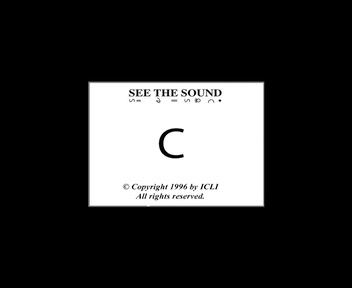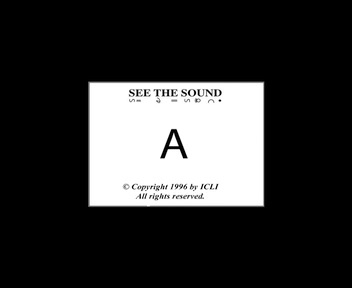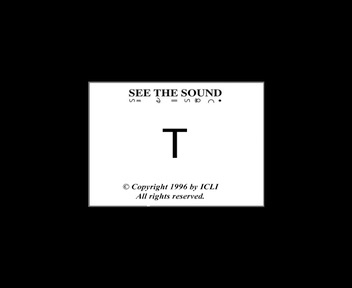What is See the Sound - Visual Phonics?
See the Sound - Visual Phonics is a system of 52 unique hand cues and symbols that represent the sounds of English without the ambiguity of English orthography. Included are the sounds commonly referred to as vowels, consonants, diphthongs and digraphs. It is somewhat of a simplified, visual, kinesthetic version of the International Phonetic Alphabet (IPA).
In English there is not a consistent one-to-one correspondence between the letters in a word and the sounds those letters supposedly represent. Consider the words "dough," "through," "thought," "tough." In each case the "ough" stands for a completely different sound. Many beginning readers have no real problem with these ambiguities, but for others the "untrustworthiness" of English spelling becomes a life long handicap. It's too confusing for them and they simply never learn to decode well. They spend years in "remedial work" and never get the chance to read really deep or interesting text; many get frustrated and bored and end up giving up on reading entirely.
See the Sound - Visual Phonics has a way to break that cycle. Each student is taught a hand cue for each of the 46 sounds in English. Each hand cue is associated in some way with the production of the particular sound. The hand cue for the sound "t" makes is made by flicking the forefinger off the thumb at the same time the tongue "flicks" off the top of the mouth. The written symbol is a simplified picture of the hand cue. Most beginning readers remember the hand cue and then look at their hand to write the symbol. The written symbol for the "t" sound is

Click on the video clips below to see the sounds in the word "cat."
Once beginning readers have learned some or all (depending on age) of the hand cues, they can begin to decode words using these symbols as a crutch. They read ![]() as they make the hand signs to help them blend the sounds into a word. All the symbols can be used at first and then reduced to only those letter combinations that are confusing, and finally dropped altogether as they learn to recognize the word on sight. Consider the four words we mentioned in the beginning
as they make the hand signs to help them blend the sounds into a word. All the symbols can be used at first and then reduced to only those letter combinations that are confusing, and finally dropped altogether as they learn to recognize the word on sight. Consider the four words we mentioned in the beginning
The Visual Phonics symbols make it very easy to teach the differences in sound and spelling. Because the sounds and written symbols are so perfectly consistent many readers internalize the standard spelling rules without being taught them directly. This speeds up their reading and improves comprehension.
Who will benefit from using See the Sound - Visual Phonics?
- Students that read below grade level in regular education settings, or in special service programs.
- Children in early education programs, also "at risk readers."
- Special education students and students with disabilities.
- Deaf and Hard of Hearing students (DHH), students with hearing loss at all levels.
- English Language Learners (ELL), students learning English as a second language.
- Adults who are not literate or read below an 8th grade level.
How does See the Sound - Visual Phonics help?
- See the Sound - Visual Phonics is the first step to reading, sound (not the alphabet) is the root of language. All languages are based on sound and their written forms should, but often do not, reflect those sounds. Languages can be very confusing; many people struggle when trying to learn them. See the Sound - Visual Phonics is a good crutch for those that struggle.
- See the Sound - Visual Phonics is easy to use. Once a student has learned it he has a powerful tool to help him learn basic literacy and communication skills. Most beginning readers learn it more quickly than other methods. Many "remedial" readers can learn it in a few weeks.
- See the Sound - Visual Phonics helps students pronounce and understand words so quickly that almost from the beginning comprehension, not decoding, becomes the natural focus of reading. With Visual Phonics symbols underneath the words, a student can quickly read materials that match his spoken vocabulary and not his "decoding skills."
 is not any harder to read than
is not any harder to read than , but potentially much more interesting to an older student. The font CD makes it easy to type Visual Phonics symbols under any reading material.
, but potentially much more interesting to an older student. The font CD makes it easy to type Visual Phonics symbols under any reading material.
- See the Sound - Visual Phonics is very cost effective and can be incorporated into almost any traditional reading program to create a comprehensive curriculum. It can also stand alone, with an excellent, creative teacher.
- See the Sound - Visual Phonics is a light that makes clear how spoken language relates to written language. It is an approach to language that opens the door of sound for all those who need a little extra help.
The QuickTime player is required to play the three video clips on this page, if you do not have the QuickTime player installed on your computer, follow this link to download QuickTime player.

Into Light


